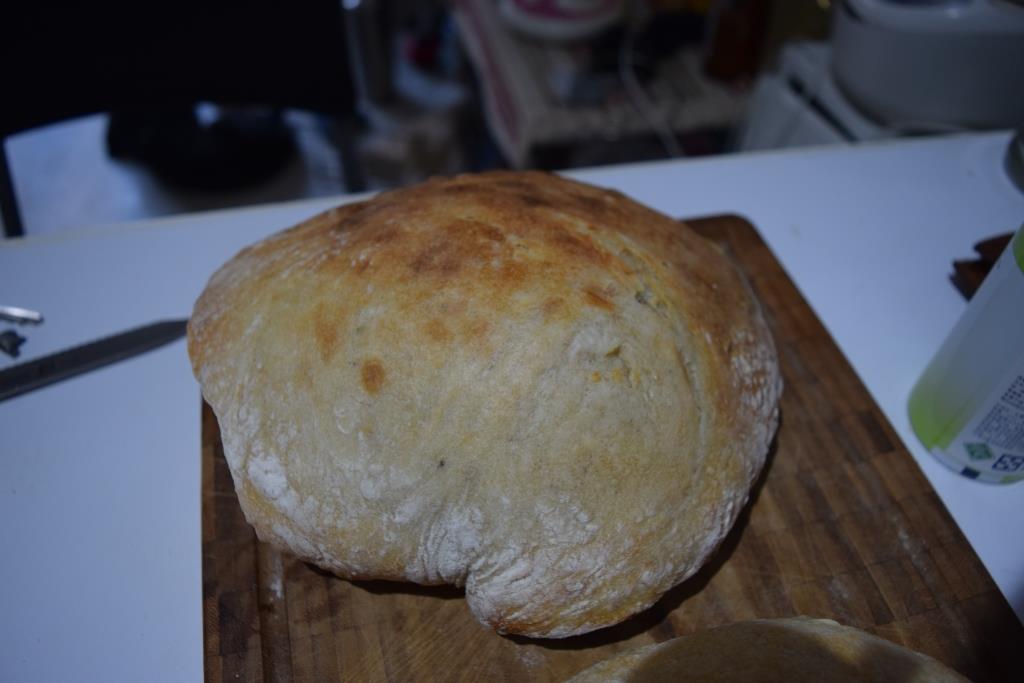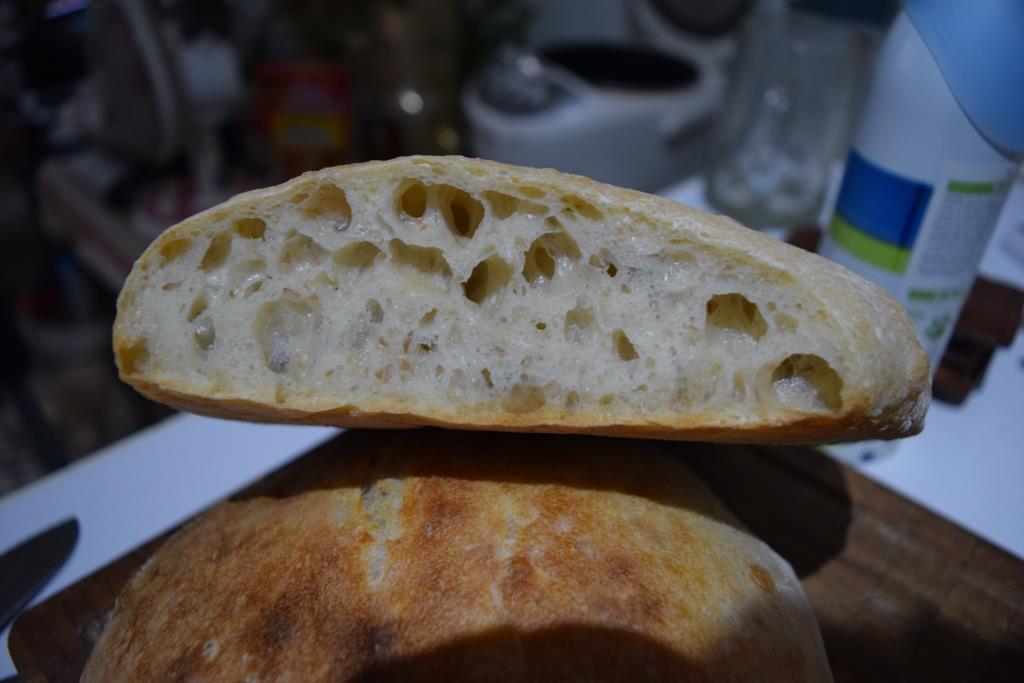Sourdough poolish Ciabatta with Whole Rye Grains and Rosemary
Sourdough poolish Ciabatta with Whole Rye Grains and Rosemary

Description
The recipe is adapted from Peter Reinheart's "ciabatta, poolish version" in The Bread Baker's Apprentice. My modification was to make it sourdough and to add some grains and herbs just for something different. The recipe also utilizes Reinhart's "barm" starter recipe, which I made from scratch about a month ago and it is just wonderfully active. Any wet starter should do the trick though. I added one cup of this starter to his poolish recipe, adjusted the other ingredients' weights, and then followed his basic poolish ciabatta recipe from there. The other personal touches I added were about 1tbs of dried rosemary and about 1/3 cup cracked pumpernickel rye that I soaked overnight. Both were lovely additions that don't "take over" the flavor but add a nice little accent.
As much as I love the crumb on this bread, and am thrilled with how big the holes are, I want to make it even better next time! This was the wettest dough I've ever worked with. It's also probably the worst shaping job that I've ever done!---but I'm working with the space and resources I've got. Any tips on shaping these things and getting a more even crumb would be greatly appreciated.
Summary
| Yield | |
|---|---|
| Source | Peter Reinhart *The Bread Baker's Apprentice* Poolish Ciabatta recipe, with variations |
| Prep time | |
| Cooking time | |
| Total time |
Ingredients
Instructions
Day 1
The night before you bake, mix together the poolish, let it sit out for about 3 or 4 hours or until you start seeing activity, and then put it in the fridge overnight. The poolish helps with the flavor on its own, but since I wasn't being kind to my sourdough starter this week, I also wanted to give it a night in the fridge with the poolish to wake up a bit, and it sure did!
Day 2
For the final dough, take the poolish out of the fridge about 1 hour before you use it, to take off the chill. Mix the flour, salt, rosemary, and rye grains in a large bowl. Then, add the water, olive oil, and poolish. Mix with a paddle (or use a mixer if you've got one) for about 5-7 minutes until the dough starts looking smooth and proper. Mine looked like this:
Now if my math is right, that comes out to 78% hydration.** (I miscalculated and incorrectly said 142% hydration first---my mistake!) Yikes! The wetter the better if you can manage it though. This dough was pretty messy to work with, but I managed. For the next step, I dust a patch of countertop with flour and get your trusty dough scraper ready to help with the stretch-and-fold method. Give it two folds, oil it up, cover it with plastic wrap, and then let it rest for 30 minutes. Looks like this when it's all done:
Repeat the folding and oiling process again after 30 minutes have passed and then let it ferment on the countertop for 2 hours. When I came home, it had really spread out under the plastic wrap and was basically just a blob, like this:
(It almost started dripping off the countertop! I don't know if there's a better way of letting ciabatta dough ferment but I don't think there's much getting around the mess with such a wet dough.)
Cut the dough in half, gently "shape" the blobs into "loaves," and then let them sit for 30-40 minutes. (Sorry but no picture of that process...)
Preheat your oven to 500F (mine can only make it to 250C [482F] unfortunately) and pop them on your stone (or pan, however you do it.) with a pan of hot water for steam. Spray the inside of the oven with more water at 30 second intervals for the first 1.5 minutes. Then, wait about 10-15 minutes or so until they reached 205 inside and are golden brown on top.
Notes
Now for the results:
Here are the two loaves fresh out of the oven. Of interest, the one loaf puffed up in the middle noticeably more than the other. The holes are massive at the center, but the edges are quite tight. On the second loaf, the holes are much more even and the rise was much more uniform. I don't know what the explanation is, but I'd be willing to hear any theories. Perhaps I shaped them differently? I'm not sure. Delicious anyway!

I might have taken this one out of the oven too early, but it's still delicious. Ciabatta doesn't need crust anyway.



Just some olive oil for dipping is all I need to enjoy this bread! Delicious!
- Log in or register to post comments
- Printer-friendly version
Comments
is 70%...... if it is all liquid then the hydration is 97% ....... 142% would be totally unworkable - you would get flat breads like pita at best or pancakes at worst. This looks like it is the 90's% somewhere.
The trick to ciabatta is that you flip it over right before you bake it in order to redistribute the air pockets properly.
Yours looks delicious and just the right height to split in half and put in a paninni press for sandwiches. Well done and happy baking
PS - here is a video showing how to handle a 99% hydration ciabatta
https://www.youtube.com/watch?v=v24OBsYsR-A
You're totally right about the hydration. I will update. I calculated for the amount of water in the poolish but didn't account for the flour there as well, so the 142% reflected the final dough bread flour (13.5oz) not the 25oz total flour. With 3.5oz water in the barm, 8oz in the poolish, 6oz in the final dough, and 2oz olive oil, that's 78% hydration, which is I guess normal for a ciabatta? Will try and push it to 80%+ next time.
Thanks for the flipping trick and the video link. I will definitely need that for my next, wetter try!
450-500 g of water depending on what kind of flour I use. If I have fresh milled whole grains in there, say 25%, I would be at the 100% hydration mark, If it is all AP then 95% works out pretty well. The percent of pre-fermented flour changes with the season more in winter say 20% and less in summer - around 10%.
I don't use a mixer though. It is one sloppy mess when making by hand but that is where the fun is!
Happy ciabatta making.
since it is a fat and has no water in it. It does usually make the dough feel different though if used in high enough quantities. The thing to rememner about fats and oils is that you want the dough to totally hydrated with the water first before adding any fat. The fat will coat the starch in the flour and hkeep it from hydrating properly. Best to autolyse well first with just flour and water - no levain, no yeast, no salt and no fat.
Happy ciabatta making
that's great advice with the oil. I've tried it both ways but haven't paid much attention. Will add it after the hydration from now on. I included it in the hydration because Reinhart says you can replace the water with oil, so I wouldn't have thought that would be advice to give if it affects the hydration. Also have a hard time believing the hydration would then be only 70%? Well, that's what the numbers say! Will update when I get a chance.